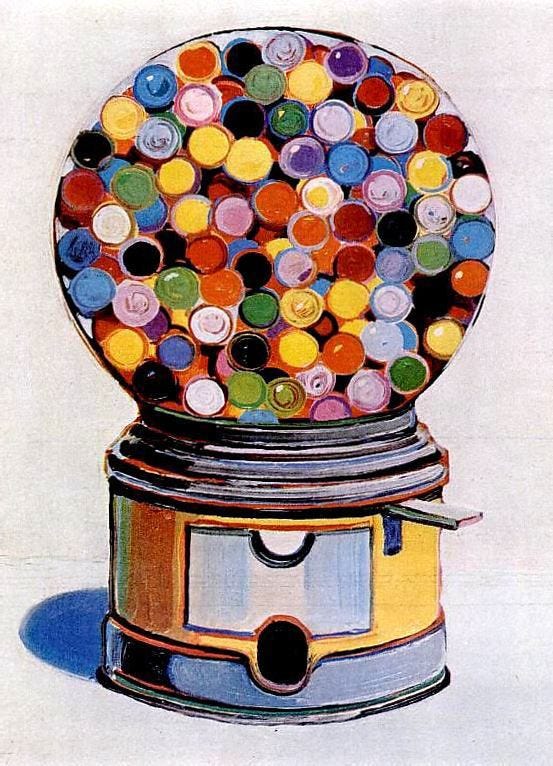Q.A. (*NO QUESTIONS ASKED*)
If you know someone who is struggling with symptoms of depression or trauma that may benefit from this newsletter, please reach out to me with their email address, and I will provide them with a 60-day subscription that includes full access, no questions asked.
email: jackie@illustratingjoy.com | subject: N.Q.A.
Introduction:
Am I a happy artist?
Hardly. That's why I research holistic ways to find happiness so diligently. There are many podcasts, including faith-based, medical, and scientific ones where I find the answers I seek.
If someone doesn't have the time to spend two to three hours digesting this information, I often share what I find to be the most relevant or cutting-edge summaries. (More on Dr. Roger Seheult’s recent podcast below)
I have always believed that those who follow Christ are meant to share in His suffering, and that suffering is part of this fleeting journey.
As someone who constantly feels a heavy, “angsty” cloud over my emotions, I was surprised when I first heard about artist Wayne Thiebaud.
When someone in a meeting would say, “I just want to be happy,” I immediately judged them as self-centered and shallow. Silently, I would berate them in my mind, “it ain't about your happiness anymore, sweetheart, it's about lifting the load so that others may feel less pain.”
As I continue my spiritual seeking, keeping my eyes on God, maybe I’ve had this happiness thing all wrong.
Maybe it's okay to pursue inner happiness without tying it to a specific outcome or person.
When I discovered Wayne's work at the Nelson Atkins a few years ago and realized he's the first artist to reject the pervasive darkness through which many of the greats view and paint life, I was shocked and pleasantly surprised.
Wayne Thiebaud
American artist, Wayne Thiebaud (born November 15, 1920-died December 25, 2021 age 101 years) was known for his colorful paintings of cakes, pies, gumball machines, and other everyday objects, had a unique relationship with the idea of happiness in art.
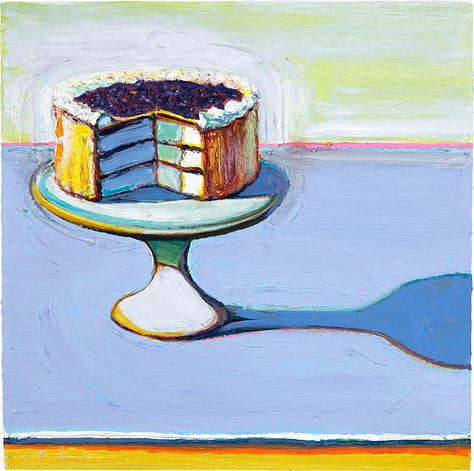
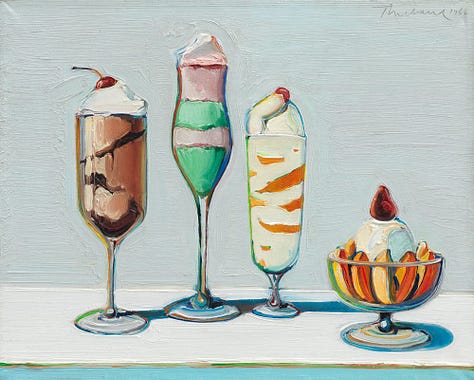

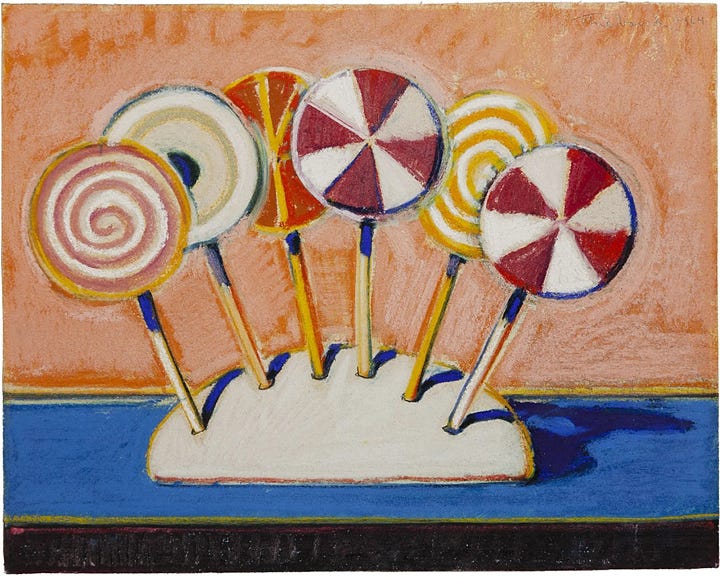
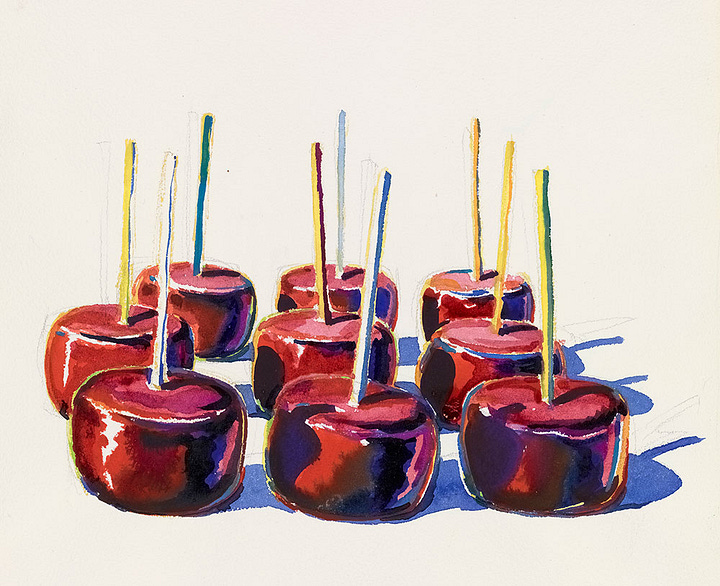
Thiebaud painted simple, familiar subjects—desserts, toys, cosmetics—not because they were glamorous, but because they represented pleasure, nostalgia, and warmth. His work celebrated the small delights of daily life. By rendering them with care and vibrancy, he elevated these items into something joyful.
“What I wanted to do was to paint as if I were painting happiness,” Thiebaud said.
He used bright, cheerful colors, strong shadows, and a stylized, almost cartoonish realism that evoked a sense of innocence and playfulness. His technique—thick paint and vibrant colors—made objects almost edible, inviting a sense of wonder and pleasure.
Unlike pop artists like Warhol, Thiebaud was not critiquing consumer culture. His cakes and gumballs were sincere celebrations of life. His art wasn’t about what’s wrong with the world; it was about what’s still beautiful in it.
Thiebaud’s subjects often evoked a sense of Americana, childhood, and a simpler time. His work is imbued with emotional warmth, suggesting that happiness is found in memory, comfort, and familiarity.
His paintings invite viewers to slow down and find joy in the everyday. Rather than making grand philosophical statements, Thiebaud’s work quietly suggests that happiness can be sweet, simple, and right in front of us—like a piece of cake.
I recently bought a children’s book of his work for my grandkids because I was so enamored with his positive outlook, I believed eventually these kids-who I love with all my heart, would benefit from this great mans philosophy and work.
The older I get, the more I realize those kind hearted, positive souls among us who strive for happiness have chosen the road less traveled, and I damn well want to join them.
So how do we begin to feel better…?
Dr. Roger Seheult’s, shared a powerful story about a young man, aged 15,
who contracted a severe flesh-eating disease and was dying. They had removed one lung in an attempt to save him, while discovering the remaining lung was also infected.
His mother asked how long he had to live, the doctor replied, “two days.”
The young man made a final request, “please, get me outside.”
The doctors broke protocol, and through great effort wheeled him out into the sunlight.
Miraculously, his body responded: inflammation reduced, tissue began to heal, and his immune system strengthened. Against all odds, he began to recover.
This story illustrates the body’s capacity to heal when given the right environment, even in life-threatening situations.
If you've fought chronic depression, (also a life-threatening illness) one cannot expect to “find happiness” if your body is in a state of chronic inflammation and fatigue.
As we learn to rewire our brains together, let's take a couple of minutes to read how this doctor, after years of critical care and life-saving efforts, simplified the approach for anyone who wants a better quality of life can follow.
Take note how faith plays a role in recovering ones health.
I've summarized the “8 Pillars” from this brilliant doctors approach.
Dr. Roger Seheult’s appearance on The Diary of a CEO with Steven Bartlett, summarized his approach into 8 pillars.
1. Nutrition
Benefit: Fuels the body, supports immune function, reduces inflammation, and can prevent chronic diseases.
Emphasis is placed on whole, plant-rich foods and limiting ultra-processed foods.
2. Exercise
Benefit: Enhances cardiovascular health, improves insulin sensitivity, boosts brain health, and increases lifespan.
Walking after meals helps with blood sugar regulation.
3. Water
Benefit: Essential for cellular function, detoxification, and circulation.
Dehydration can lead to fatigue, poor concentration, and kidney stress.
4. Sunlight
Benefit: Regulates circadian rhythms, boosts vitamin D, increases dopamine, and supports mood and immunity.
Morning sunlight and infrared light exposure have unique biological benefits.
5. Temperance (Self-Control)
Benefit: Avoiding harmful substances (e.g. alcohol, nicotine, excessive caffeine) and practicing moderation reduces stress on organs and improves long-term health outcomes.
6. Air (Fresh)
Benefit: Proper oxygenation improves energy levels, brain function, and sleep.
He emphasizes minimizing indoor air pollution and increasing ventilation. [THROW AWAY AIR FRESHENERS OF ANY TYPE!]
7. Rest (Sleep)
Benefit: Deep sleep supports immune repair, hormone balance, brain detoxification, and emotional regulation.
Avoiding blue light at night and sleeping in complete darkness enhances melatonin production.
8. Trust (Spiritual/Faith-Based Coping)
Benefit: Reduces stress, enhances emotional resilience, and may lower inflammation.
Practices like prayer, meditation, or belonging to a community support mental health.
Each pillar is interconnected, and Dr. Seheult stresses that consistent, small habits in all these areas can dramatically reduce chronic disease risk and enhance vitality. The acronym is NEWSTART, reminds us that we can start today on a better life.
The best part of this interview is when the good doctor said he is lobbying to get all hospitals to offer outdoor access to sick patients.
✅ I want to see your art!
Please tag any art posts on insta so I can check out your work.
*UPGRADE Your Subscription*
VIDEO: 🎨 Step Into the Studio
Watch the art come alive—with me as your guide.
For just $7/month, you’ll get:
💬 Unfiltered creative insight (I keep it real…think the Disaster Artist meets Bob Ross)
🎥 Artist-led video tutorials
🧠 The meaning behind each piece
This isn’t just art—it’s your invitation to connect, create, and heal.
Click below to begin.
Testimonials: People I’ve worked with say it best—discover their stories and insights about working with me.
Video Overview:
Keep reading with a 7-day free trial
Subscribe to The Art & The Calm to keep reading this post and get 7 days of free access to the full post archives.




